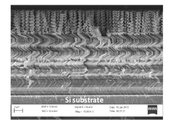Highlight
Novel broadband THz antireflection coating with graded index spiral structures
Achievement/Results
A multidisciplinary research team at Rensselaer Polytechnic Institute has developed a unique graded index nanostructure for THz anti-reflection coating that will change the landscape of antireflection coating. The team consists of IGERT trainee, Michael Riley (Chemical Engineering Department and THz Center), his joint supervisors professors Toh-Ming Lu (Physics) and Joel Plawsky (Chemical Engineering) and collaborators Dr. P. Han and professor X.-C. Zhang (Physics and THz Center).
Anti-reflection (AR) coating at THz frequency range is becoming more important with the expanding application in THz spectroscopy. Traditionally multilayer coatings with graded THz index were used for broadband AR. Usually the design and fabrication were complicated due to the lack of materials, which should have low absorption and suitable refractive index in the THz range. Here we have used the same Si material to fabricate graded index spiral structures with a continuing change of spiral density from the dense Si substrate (index=3.4) to air (index=1) on a Si wafer using the oblique angle deposition technique. The deposition was performed in an e-beam evaporation system with a substrate to source distance of 30 cm.
Figure 1 shows a cross section SEM image of the graded index Si AR coating. The sample film has 5 different layers from bottom to top. The first layer is a tilted Si nanorod layer of 0.7 µm thick. Then three squared arm spiral layers with different rise angles (therefore different density) of 3, 5, and 6 µm thick were deposited. The top layer is composed of circular spiral Si with a thickness of 5 µm. The total thickness is about 20 µm. Therefore, the layer closer to the silicon substrate was denser with higher refractive index and the layer close to the ambient air was less dense.
The average deposition rate was ~1 nm/s and the whole film was deposited in a single run for about 8 hours. The spiral architecture is achieved by using the oblique angle deposition technique in which the flux arrives at the substrate with an angle with respect to the surface normal. Islands of different heights are initially nucleated at the surface. Subsequently the incident flux of material that strikes the surface with an oblique angle is preferentially deposited onto the top of surface features with larger height values. This preferential growth dynamic gives rise to the formation of well-separated nanostructures.
This relatively unexplored technique has been proven to be very robust and can be used to produce nanostructures with a wide variety of sizes and shapes depending on the incident flux angle, deposition rate, and substrate rotation speed. In particular, the spiral structure shown in Fig. 1 was fabricated by dynamically varying the incident flux angle and substrate rotation speed for different layers of deposition. Two different THz time-domain spectroscopy systems were used for the characterization of the sample: a conventional THz time domain spectroscopy (TDS) system and an air-breakdown coherent detection (ABCD) THz spectroscopy system. The conventional THz TDS has a useful bandwidth up to 4 THz with a dynamic range of 70 dB. The available bandwidth of ABCD system spans from 0.1 THz to 15 THz with a slightly lower dynamic range. It was found that the AR performance of the graded index sample shown in Fig. 1 is very broadband, ranging from below 1 THz to over 7 THz with a maximum reduction of reflection over 50% compared to that of Si wafer. The average index of the film is 1.76.
Address Goals
The use of silicon films is advantageous because no foreign material is needed and no excessive reflection at interfaces occurs as a result of dissimilar materials. Furthermore, the fabrication is simple and the graded film can be obtained in a single deposition run. The structure shown in Fig. 1 is far from optimized. With a more careful design of the layer thickness, it is possible to obtain a very broadband and efficient THz AR coating at low cost.






